This post is about Roman Germany – something I used to think was a contradiction in terms. So I shall to start with a map to show what I mean.

The Roman Empire
Continue reading Germany: the Roman Empire Stops Here
Please share this page...
This post is about Roman Germany – something I used to think was a contradiction in terms. So I shall to start with a map to show what I mean.

The Roman Empire
Continue reading Germany: the Roman Empire Stops Here
Please share this page...
Never mind about the ‘Shock of the New’, sometimes the Shock of the Old can take your breath away just as forcefully. Have a look at this large plate:
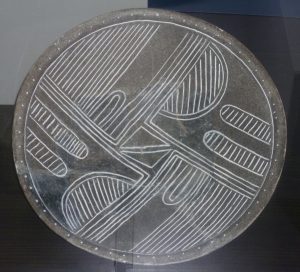
How old do you think it is? Could it be by Picasso, who became interested in ceramics in the 1950s? Or are we talking 1980s Scandinavian?
Continue reading Bulgarian pottery: the Shock of the Old
Please share this page...
Tuscany, Italy, last year. The first thing our guide to the Etruscans said was, ‘Everyone calls the Etruscans “mysterious” and it’s simply not true.’ By the end of the week, I thought: You’re wrong. Yes, thanks to archaeology, we can see inside their tombs; admire their grave goods, the amazing terracotta sculptures, and their famous black bucchero ware; and we know what the Romans thought of them. But, for me, the Etruscans themselves still remain fascinatingly elusive. This is why.
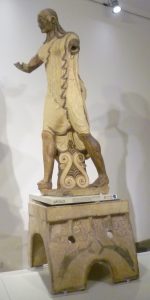
Apollo, from the temple at Veii
Continue reading The Mysterious Etruscans
Please share this page...
Gerald Durrell’s My Family and Other Animals was a favourite teenage book, and it introduced me to the rose beetle. Soon after he arrived in Corfu in 1935, Gerry met the rose beetle man, an itinerant pedlar wearing a floppy hat covered in feathers, and a patched, pocketed coat, bulging with knick-knacks for sale. Bamboo cages holding a variety of birds bounced on his back, and he held ‘a number of lengths of cotton, to each of which was tied an almond-size rose-beetle, glistening golden green in the sun, all of them flying round his hat.’

My much loved copy of ‘My Family and Other Animals’ by Gerald Durrell
Continue reading The Rose Beetle
Please share this page...
Ever since Roman times, the rich and powerful have built villas in the hills surrounding Rome to escape the summer’s heat. Some, like Hadrian’s villa at Tivoli, still survive. Others, like Castel Gandolfo, built in the 17th century for Pope Urban VIII as a summer palace, were built on top of Roman villa sites. And why not? The land was already levelled and useful top quality building material was there for the taking.
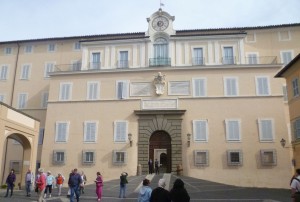
Castel Gandolfo, the papal summer palace
Continue reading From Domitian’s Villa to the Papal Barberini Gardens
Please share this page...
Sometimes, what attracts me to a place is simple aesthetic pleasure; I just like the look of it. Take Kakopetria, a traditional stone village in the foothills of the Troodos mountains in southern Cyprus.
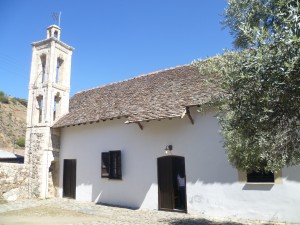
The old church with its steeply-pitched roof
There’s nothing grand about it; it’s been there for ever and it’s remained much as it always was. I don’t doubt that the Cypriot Tourist Board has done some restoration but their work hasn’t been intrusive. They may have whitewashed it – several years ago; but real people live here, hang up their washing on the wooden balconies, and chat in doorways.
Continue reading Kakopetria: a traditional Cypriot village
Please share this page...
One thing I love about travelling is suddenly seeing that unexpected something which sends shivers down your spine and makes the hairs on the back of your neck stand up: the beautiful gardens of Ninfa in Italy; local fishermen dancing in an old waterfront warehouse in Crete; or a small ruined temple set amidst olive groves full of spring flowers in Turkey. And at Agrigento in Sicily, I saw the telamon.
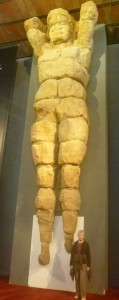
The telamon in Agrigento Museum.; c0mpare his height with that of the women standing by his feet.
Continue reading Agrigento, Sicily: the Wow! factor
Please share this page...
Some years ago I saw a rom.com where the American heroine visits London for the first time. She lands at Heathrow and takes a cab to wherever she’s staying – somewhere fashionable with a SW postcode. She peers excitedly through the cab window as Buckingham Palace, the Houses of Parliament, St Paul’s Cathedral and Tower Bridge whizz by. I thought: where the hell is the cabbie going? Then the penny dropped: his circuitous route in the wrong direction had nothing to do with the real London; it was a fictitious ‘London’.
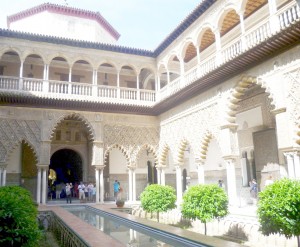
The Alcazar: the Spanish Royal family’s summer palace in Seville
I’d always felt much the same about the cigarette factory in Seville in Bizet’s opera Carmen. It must be fictitious. Bizet took his plot from a novella by Prosper Merimee and I doubted whether either of them had actually been to Spain. Merimée probably thought Seville sounded romantic and what was really important wasn’t the unlikely cigarette factory but the romantic toreador at the centre of the story.
Continue reading Carmen and the Seville Cigarette Factory
Please share this page...
This is one of the first things that greets you at the Park of Monsters, a.k.a. the Park of Wonders or the Sacred Grove at Bomarzo, in Lazio, Italy. It is so huge that when you stand up inside the gaping mouth you have to reach up to touch its teeth!

The Mask of Madness
Continue reading Bomarzo: The Park of Monsters
Please share this page...
What happened to the Roman temples and public buildings after the fall of the Roman Empire when they suddenly became redundant? The answer is simple: they were robbed for building materials.
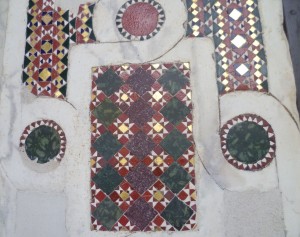
Cathedral church of Santa Maria Maggiore, Civita Castellana: exterior Cosmati decoration (note the gold for added glitter)
Just think how much material there was to take! All over the Roman Empire there were thousands of temples, expensively clad in marble – some of it carved, and with marble or stone columns supporting pediments and roofs of dressed stone. And that was just the temples. Every Roman town would have had its forum, with colonnades, amphitheatre, public baths, and dozens of other public buildings, all made of expensively cut stone and marble.
Continue reading The Fabulous Decorative Work of the Cosmati family
Please share this page...